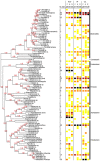Disordered microbial communities in asthmatic airways
- PMID: 20052417
- PMCID: PMC2798952
- DOI: 10.1371/journal.pone.0008578
Disordered microbial communities in asthmatic airways
Abstract
Background: A rich microbial environment in infancy protects against asthma [1], [2] and infections precipitate asthma exacerbations [3]. We compared the airway microbiota at three levels in adult patients with asthma, the related condition of COPD, and controls. We also studied bronchial lavage from asthmatic children and controls.
Principal findings: We identified 5,054 16S rRNA bacterial sequences from 43 subjects, detecting >70% of species present. The bronchial tree was not sterile, and contained a mean of 2,000 bacterial genomes per cm(2) surface sampled. Pathogenic Proteobacteria, particularly Haemophilus spp., were much more frequent in bronchi of adult asthmatics or patients with COPD than controls. We found similar highly significant increases in Proteobacteria in asthmatic children. Conversely, Bacteroidetes, particularly Prevotella spp., were more frequent in controls than adult or child asthmatics or COPD patients.
Significance: The results show the bronchial tree to contain a characteristic microbiota, and suggest that this microbiota is disturbed in asthmatic airways.
Conflict of interest statement
Figures




References
-
- Eder W, Ege MJ, von Mutius E. The asthma epidemic. N Engl J Med. 2006;355:2226–2235. - PubMed
-
- Cookson WO, Moffatt MF. Asthma: an epidemic in the absence of infection? [comment]. Science. 1997;275:41–42. - PubMed
-
- Sykes A, Johnston SL. Etiology of asthma exacerbations. J Allergy Clin Immunol. 2008;122:685–688. - PubMed
-
- Cookson W. The immunogenetics of asthma and eczema: a new focus on the epithelium. Nat Rev Immunol. 2004;4:978–988. - PubMed
Publication types
MeSH terms
Substances
Grants and funding
LinkOut - more resources
Full Text Sources
Other Literature Sources
Medical
Molecular Biology Databases
Miscellaneous

